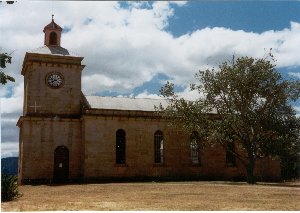|
|
 |
 |
|
Featuring the historic towns along the Midlands Highway,if you would like your historic town featured on Tasmanian heritage please email me at cleanup2000@elaunceston with text and graphics.
|
 |
 |
 |
|
PONTVILLE/BRIGHTON The Barracks Midland Highway. Pontville.
Three sandstone terrace cottages,convict built. AVOCA Formally known as Camp Hill and St Paul's Plains, Avoca
is a principal town in the Fingal Valley on the Esk
Highway, 27kms from the Midlands Highway.
Avoca is located at the junction of the St Paul's and South Esk Rivers, and serves the communities of Royal George
and Rossarden.

John Wedge, surveyor and explorer, named the town in
1833, having been inspired by the Thomas More poem
'The Sweet Vale of Avoca'. Avoca's namesake is in
County Wicklow in Ireland.
There are a number of historic colonial buildings including
the Parish Hall, the Union Hotel, and St Thomas's Church.
CLEVELAND It was originally proposed that Cleveland become the main
centre for the Midlands, but limited water resources put pay to that idea.Instead, Cleveland became a popular coaching stop, and a depot for ticket-of-leave convicts. In colonial times, Cleveland boasted three coaching inns, namely St Andrews Inn, the Bald Faced Stag, and the Squeaker - the latter no longer standing today.
Some say Cleveland was named after a breed of horses imported and bred in the district. Others sources claim
that Governor Macquarie name Cleveland after Wm. Harry Vane, Ist Duke of Cleveland (1766-1842), who was a well known English MP, foxhunter and patron of the turf. Horse races were held at Cleveland on a course behind the Bald Faced Stag, and early motor bike races were also held there.
|
|  |
|
EPPING FOREST Epping Forest, just north of Campbell Town, was the site
of a daring stage coach robbery by the notorious bushranger, Martin Cash. It is said that he robbed all the passengers of their belongings, except for Mrs Cox, the owner of the coach, because she was a widow.
Epping Forest, was named by Governor Macquarie in 1811
|
|
 |
|
JERICHO COMMANDANT'S COTTAGE Park Farm. Jericho. 7030
A Georgian, sandstone cottage built in 1842 for the
Superintendent (known as The Commandant) of the convict
road gang
KEMPTON Wilmot Arms Inn Main Road Kempton
1834 Colonial Coach Inn
|
|  |
MELTON MOWBRAY OATLANDS Oatlands has the largest collection of
Georgian architecture in a village situation
\in all of Australia! Oatlands Lodge 92 High St. Oatlands
1830 colonial convict-built sandstone
two storey Georgian house. 
Callington Mill is the only eminently restorable mill
of its kind in Australia.
The mill has all its working buildings still intact |
 |
|
CAMPBELL TOWN The convict-built Red Bridge
over the Elizabeth River (1838)
 Campbelltown 134 kms from Hobart, and 68 kms from Launceston. is a major pastoral and tourist centre in the Northern Midlands rich in history:
Originally established in the 1820's by Governor Macquarie as one of the four garrison towns between Hobart and Launceston.
Campbell Town, and the Elizabeth River, which runs through it (previously known as Relief Creek), were named by Macquarie after his wife, Elizabeth Campbell.
It was proclaimed a town in 1866, boasts an impressive collection of colonial architecture including the
Foxhunters Return (1834),
The Grange (1847) (Dr William Valentine's home,
The convict-built Red Bridge
over the Elizabeth River (1838),
The Old Brewery (1847)
churches range from the tiny Wesleyan Chapel to imposing St Luke's (1839) and St Andrews (1857)
St Michaels (1857).
The Campbell Town Golf Club, adjacent to the Midlands Highway, was originally a race course.
Georgian-style inns
The Harold Gatty Memorial park which remembers the achievements of Harold Gatty, a navigator who, in 1931, flew with American pilot Wiley Post around the world in eight days, was born in Campbell Town in 1903
The annual Campbell Town Agricultural Show is the oldest of its kind in Australia, having run continously since 1838.
Elizas Cottage Life on the Farm Wander round the old brick woolshed, the smithy's shop with
its old bellows and forge, the cow byre, the gardens - where the trees planted in 1821 still grow.
Campbelltown has always been popular with artists,with
weekends at The Grange.
A popular artist and photographer Craig Cooper was born in Campbell town. |
|
 |  |  |
|



